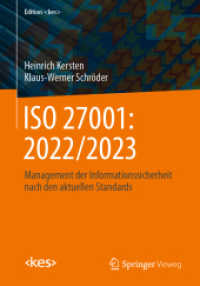Full Description
Teaching K-12 math becomes an easier task when everyone understands the language, symbolism, and representation of math concepts
Published in partnership with SEDL, The Problem with Math Is English illustrates how students often understand fundamental mathematical concepts at a superficial level. Written to inspire ?aha? moments, this book enables teachers to help students identify and comprehend the nuances and true meaning of math concepts by exploring them through the lenses of language and symbolism, delving into such essential topics as multiplication, division, fractions, place value, proportional reasoning, graphs, slope, order of operations, and the distributive property.
Offers a new way to approach teaching math content in a way that will improve how all students, and especially English language learners, understand math
Emphasizes major attributes of conceptual understanding in mathematics, including simple yet deep definitions of key terms, connections among key topics, and insightful interpretation
This important new book fills a gap in math education by illustrating how a deeper knowledge of math concepts can be developed in all students through a focus on language and symbolism.
Contents
The Author xiii
About SEDL xv
About This Book xvii
Introduction xix
Julian's Story xix
Rationale and Purpose xx
Who Benefits from This Book? xxii
One The Problem with Math Is English (and a Few Other Things) 1
Why Language and Symbolism? 1
What We Are Teaching 4
Turning the tide: A Sampling of Approaches 6
Mathematics Is About Relationships 8
Connecting the Pieces and Looking Ahead 9
Two Why a Language Focus in Mathematics? 11
The Convergence of Mathematics and English: More Than Just Vocabulary 11
Problems Based on the English Language 13
A Number of Problems with Number 16
Three Language and Symbolism in Traditional Instruction 21
Shortcomings of Traditional Instruction 22
More Language and Symbolism Issues: Adding Fuel to the Fire 32
Tell Me Again Why the Language Focus in Math? 38
Four So What Does Conceptual Understanding Look Like? 41
It Starts with Definitions 42
Making Connections in Math: Beyond Connecting Dots 51
The Interpretation and Translation Of Math 55
Conclusion 61
Five The Order of Operations: A Convention or a Symptom of What Ails Us? 63
The Roots of the Rules 64
The Natural Order: A Mathematical Perspective 65
Conclusion: A Conceptual Understanding of the Order of Operations 78
Six Using Multiplication as a Critical Knowledge Base 81
Understanding Key Definitions and Connections 81
Interpreting Multiplication 86
Using The Power of the Distributive Property 88
Feeling Neglected: The Units in Multiplication 100
Conclusion: Small Details, Huge Impact 103
Seven Fractions: The ''F Word'' in Mathematics 105
Defining Fractions: Like Herding Cats 105
The Fraction Kingdom 107
Interpreting Fractions 116
Conclusion 124
Eight Operations with Fractions 127
Adding and Subtracting Fractions 127
Multiplying Fractions 131
Dividing Fractions 150
Conclusion 160
Nine Unlocking the Power of Symbolism and Visual Representation 161
Symbolism 161
Visual Representation 168
The Power of Interpretation: Three Perspectives of Trapezoids 178
Conclusion 187
Ten Language-Focused Conceptual Instruction 189
Language Focus: Beyond the Definitions 190
The Secrets to Solving Word Problems 192
Suggested Instructional Strategies 197
Conclusion 216
Eleven Mathematics: It's All About Relationships! 219
Language and Symbolism: Vehicles for Relationship Recognition 220
Relationships and Fractions 224
Proportional Reasoning 227
Relationships: Important Considerations 230
Relationships: Making Powerful Connections 234
Conclusion 249
Twelve The Perfect Non-Storm: Understanding the Problem and Changing the System 251
A Systemic Issue 251
Math Makeover 257
Conclusion 264
Bibliography 267
Index 269








